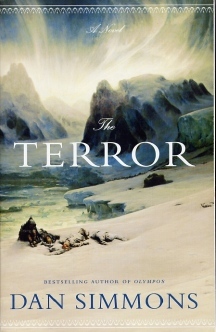We look to
novels for different types of experiences. Some novels we read to enjoy
a fast-paced adventure. Still others lure us with immersive depictions
of worlds, times or places unfamiliar to us. Others offer readers glimpses
of the imaginary, snapshots from the myths and legends that we create
both deliberately and accidentally. Few novels manage any of these individual
modes successfully. 'The Terror' manages to be all three in a single
cohesive work and offers a reading experience that is exciting, immersive
and rewarding. Simmons achieves a literary style that is complex but
straightforward. 'The Terror' is a grand adventure with an emotional
and intellectual wallop.
The novel takes as its background a true story. In 1845, the British
sent forth an expedition to find the Northwest Passage. HMS Erebus and
HMS Terror left with a combined crew of 129 men, led by Sir John Franklin
and Francis Crozier. The ships disappeared, and the ensuing search lasted
more than thirty years. From this Simmons weaves a page-turning tale
of human hubris coming face-to-face with unforgiving nature. But 'The
Terror' is much more than the story of a doomed expedition into the arctic.
Simmons novel evokes the thrill of myth, that primal cave-tale feel that
short-circuits literary conventions and goes to the heart of story.
The architecture of this novel is ambitious. We start long after the
ships were last actually seen in Baffin Bay, with things bad and getting
worse. Supplies are short, the ships are trapped and something is hunting
the men. It is intelligent and inimical, but even so, other dangers are
more pressing. Food is short. Scurvy is starting to take its toll. Francis
Crozier is beginning to realize that nobody may survive this trip. Danger
is imminent and comes from a variety of sources. Simmons then backtracks
to earlier in the expedition, when Sir John Franklin's rosy assessment
of their chances still makes sense. And thus begins a complex set of
switchbacks that move the story to and fro, inevitably towards tragedy.
But this is no simple tragedy. Simmons uses faux journals, multiple viewpoints,
staggered timelines and makes them seamless. As he imagines the slow
journey of HMS Terror and Erebus into oblivion, he crosscuts and invents
with breathtaking skill. 'The Terror' is thrilling to read by virtue
of a literary skill that is utterly transparent.
Characters come to life in 'The Terror' through both third-person narrations
from a variety of viewpoints and first-person faux journals. All of the
characters are based on the actual men who sailed aboard Terror and Erebus.
The journalist, Doctor Harry Goodsir, is a rather nebbish man, clearly
in over his head as the novel begins, but who grows in an amazingly rendered
arc over the course of the novel. Crozier is our main man, a bitter,
competent captain who is the victim of class prejudice. As the novel
begins he's a drunk who contemplates suicide when his whiskey runs out.
Sir John Franklin is an inept leader who clings to his beliefs when he
should long ago have abandoned them. This is a big novel, and there are
many other characters beyond these, all of whom take on lives of their
own. With this many characters, the peril for Simmons as a writer is
nearly as great as the peril his explorers find themselves in, but he
fares much better. Every man, woman and child is clearly created for
the reader. You won’t need a list of the dramatis personae to keep
track of everyone on board the two ships. You might need some days off
when you embark on this journey, because you will not want to put the
book down.
The thrills to be found in 'The Terror' are many and varied. There are
superb set pieces that will etch themselves in your reading memory and
become places you can go back to visit. Even though 'The Terror' is a
historical novel based on lots of careful research, Simmons manages to
inject a soupcon of the supernatural that actually enhances the realistic
feel he creates. There are scenes of wonder, terror and the two mixed
perfectly. Simmons draws on myths and magic realism to enchant the reader
even while he uses the brutal facts of the arctic environment to entrap
his characters.
For all the excellence you'll experience while you read the novel, your
expectations for the ending might tend to be diminished. The superb set
pieces, the engaging literary experimentation and complex structure are,
after all, facing an imperious truth: nobody survived. The real blast
of arctic air will not hit you until you turn that last page and experience
Simmons' fitting finale, an ending that redeems the agonizing journey
and rewards readers beyond their wildest expectations. Whatever you might
think you are looking for when you began reading 'The Terror', whatever
experience you seek as a reader, prepare to have those expectations dashed
against a literary force as unknowable, as powerful the arctic itself – Dan
Simmons.
